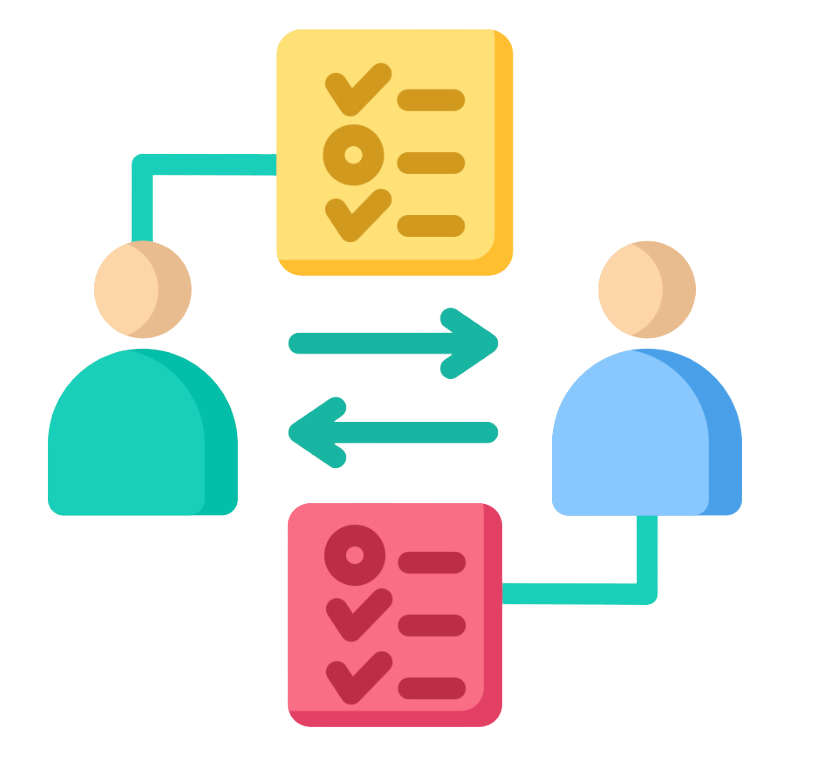Incorporating academic integrity into the classroom allows instructors and TAs to foster a fair and transparent academic environment. The following sections provide best practices for pedagogy and assessment design that can be integrated into the learning environment to boost student engagement. Learn how you can:
For instructional strategies specifically tailored to GenAI, visit AI Technology & Academic Integrity for Instructors.

Fostering Integrity Through a Positive Learning Climate

There are many ways to create a positive learning climate, whether through course design, instructional strategies, or classroom teaching practices.
The strategies in this section not only foster a positive learning environment but are also effective in preventing academic misconduct.
Contextual Influences on Academic Misconduct

Many aspects of the learning environment contribute to student willingness to engage in academic misconduct. Some of these elements are within the scope of the instructor’s influence, such as assignment clarity, skill development, or the perceived relevance of course content. Other elements may be more difficult to address, such as student stress levels, lack of confidence, or competing priorities.
Some strategies that help decrease the willingness to engage in misconduct include:
- adapting your course policies and timelines where possible can help reduce students' temptation to engage in misconduct
- sharing the skill-building resources available for students at York that help them gain confidence in their academic skills
- sharing resources from Learning Skills Services' Managing Academic Stress and/or sharing the various wellness resources at York with students to raise awareness of wellness strategies
Embedding Academic Integrity into Course-Level Learning Outcomes

By integrating academic integrity skills and values into your course-level learning outcomes, you help students recognize its significance, provide them with the tools to practice it effectively, and create a learning environment that upholds its values.
Examples include:
- "By the end of this course, students will be able to apply discipline-specific citation practices in written work and audio-visual presentations"
- "By the end of this course, students will be able to articulate the ethical standards that underpin academic integrity in this discipline"
- "By the end of this course, students will be able to interpret scholarly discourse from discipline-specific referencing practices"
Learning Outcomes Specific to GenAI Use:
- "By the end of this course, students will be able to critically evaluate the ethical use of generative artificial intelligence (GenAI) tools while ensuring their work adheres to academic integrity principles"
- "By the end of this course, students will be able to critique peer work for adherence to academic integrity standards in their field"
- "By the end of this course, students will be able to identify appropriate uses of GenAI tools for enhancing, rather than replacing, their original contributions"
- "By the end of this course, students will be able to document and justify their use of GenAI tools in accordance with academic integrity guidelines"
Facilitating Academic Integrity Discussions in the Classroom
Incorporating academic integrity-related discussion doesn’t have to take much classroom time. Including these activities leads to various benefits, including helping students to:

- consider academic integrity more deeply
- learn from their peers
- understand how academic misconduct affects others
- promote a sense of responsibility for their work and actions
- identify how academic integrity is relevant to their own lives and futures
Note: For discussion topics related specifically to the use of generative artificial intelligence (GenAI) tools, visit AI Technology and Academic Integrity for Instructors.
Perceived instructor attitudes and academic misconduct

One factor that influences academic misconduct is students' beliefs about their instructors attitudes: if they believe that their instructors do not care about cheating, students are more likely to cheat (Lang, 2013). As such, discussing cheating openly allows instructors to show students that they disapprove of cheating.
Bringing academic integrity to the forefront with your students helps dispel any misunderstandings and shows students that you care about it and are prepared to confront any academic misconduct that occurs in your courses. As an instructor, to show that you disapprove of cheating, you can discuss:
- what you do to deter test cheating (e.g. different test versions)
- that you are aware of the techniques used for different types of academic misconduct
- how you check for different types of academic misconduct
- how cheating affects you
- that you are obligated to follow through on reporting breaches

Additionally, during these discussions, you can emphasize the positive outcomes of upholding academic integrity by:

- reinforcing that the true value of education lies in learning and understanding, which engaging in academic misconduct undermines
- discussing how maintaining integrity is vital for personal and professional growth, as it builds trust among peers and others
- highlighting how doing one’s own work builds self-confidence and a sense of accomplishment
- explaining how practicing academic integrity helps students develop important skills like critical thinking, problem-solving, and independent learning
- informing students about the supports available to help them succeed without resorting to misconduct, including study groups, office hours, among various student resources
Peer Attitudes and Academic Misconduct

Students’ attitudes about cheating are also influenced by their peers: if a student believes that other students approve of cheating, and are engaging in it, then that student is more likely to cheat (McCabe et al., 2001). Yet in reality, most students strongly disapprove of their peers gaining an unfair academic advantage.
Discussing cheating in class provides an opportunity for students to show their disapproval. Some sample questions to facilitate these discussions include:
- Have you ever witnessed another student cheating? If so, how did you feel?
- When students cheat, in what ways does it impact you?
- Do you understand how to avoid plagiarism? How might you avoid it? What support do you need?
- Are you aware of the ways in which using AI-based tools may be considered cheating? (Note: For discussions specifically on GenAI tools, refer to AI Technology and Academic Integrity for Instructors)
- Do you understand what is acceptable and unacceptable when it comes to collaborating/sharing work with other students?
- Do you know what to do when students you are working with are not accountable for group assignments? If you’re in this situation, what would you do?
- What motivates students to cheat, and how can we address those pressures in a positive way?
- What can we do to create a classroom culture that supports academic integrity and discourages academic misconduct?

References:
Lang, J.M. (2013). Cheating lessons: Learning from academic dishonesty. Cambridge, Massachusetts: Harvard University Press.
McCabe, D. L., Treviño, L. K., & Butterfield, K. D. (2001). Cheating in academic institutions: A decade of research. Ethics & Behavior, 11(3), 219.
Strategies to Accomplish Both

Research shows several effective strategies that can both pre-empt cheating behaviours and deepen student learning.
Connecting with students’ intrinsic motivation rather than relying on extrinsic motivators, such as grades.
To help re-frame learning in terms of long-term, student-centred goals:
- Provide students with learning autonomy where possible (e.g. choice of topic or activity, assignment format)
- Make time for interaction with peers while encouraging exploration and discovery of course content
- Provide challenging, “real-world” problems and processes authentic to your discipline

Building knowledge and skills by scaffolding student learning.

To help students overcome procrastination and build confidence:
- Make use of practice activities and low-stakes assessments
- Break down larger projects into manageable chunks with staggered deadlines
- Have students document and share their “process” documents as part of assignments
Fostering connections in the learning environment.

To help break down psychological barriers that make academic dishonesty feel more acceptable:
- If possible, learn names and chat informally with students before and after class
- Make use of peer-based cooperative learning activities such as note-taking pairs
- Provide opportunities for all to feel comfortable contributing to class discussion (consider small group discussion, polling, and on-the-spot written responses)
Incorporate diverse perspectives, experiences, and resources in your teaching.

Articulating the “why” behind learning activities by sharing the purpose, task, and grading criteria for each assignment. (This builds confidence and metacognition skills)
- Provide a clear learning path, along with example work and grading
- Reiterate instructions in multiple formats (text, video, orally, etc.)
- Share resources targeted to common trouble spots
Academic Integrity in Practice
Take advantage of opportunities to demonstrate what academic integrity looks like in practice, so that students can see it as an explicit and active part of scholarship and knowledge-creation in your discipline.
Some ways to do this include:
- Incorporate citations for quoted and paraphrased text, images, videos, or other multimedia in your lectures or course material
- Contextualise course content within the larger scholarly conversation
- Where relevant, make connections between academic integrity standards and practices in higher education and professional practice standards in your discipline
- Discuss real-world scenarios from your academic or professional experience where you had to make ethical decisions and explain how you applied the principles of integrity in those situations
- Consider including academic integrity as a learning outcome which you can regularly reference in lectures, showing students that integrity is a core part of their learning journey

Unintentionally Encouraging Cheating: What to Avoid Doing
Just as learning environments can be structured to discourage cheating behaviours, they can also include elements that encourage cheating. Here are some tips on what to avoid:
- Don’t overemphasize the extrinsic rewards of grades as the primary motivator for learning
- Avoid an environment that focuses on student performance at the expense of student mastery of learning
- Don’t solely rely on high-stakes assessments. Incorporate safe opportunities to fail as part of the learning process!
- Don’t overload students with too much, or too difficult, coursework. Discouraged and overwhelmed students are more likely to cheat
- Don’t be vague about what constitutes academic misconduct. Ensure that students clearly understand expectations
- Avoid repeatedly using the same tests or assignments from semester to semester without substantial changes. This can make it easier for students to find previous answers or to collaborate inappropriately
- Don’t present material in a way that feels irrelevant to students’ lives or their futures. When students see the value in what they are learning beyond the classroom, they are more motivated to engage with the content
- Avoid assuming that all students know how to study effectively or manage their time. Encourage them to use academic support services

Reconsidering Assessments to Reduce Academic Misconduct

While no assessment can be entirely cheating-proof, there are effective strategies to deter academic misconduct on tests and assignments. The methods outlined in this section can help minimize the likelihood of cheating by promoting fairness and integrity in assessments.
Reduce Anxiety, Confusion, and Cheating
Reduce student anxiety, confusion, and the temptation to cheat by incorporating some specific strategies:
- Use both low- and high-stakes assessments
- Ensure all assessments have clearly stated instructions, purpose, and questions
- Where possible, use text/exam questions that require higher-order thinking rather than only simple recall of information
- Consider asking students to reflect on their learning over the course of completing an assignment, preparing for an assessment, or engaging with a course topic


- Encourage a growth mindset by emphasizing that mistakes and failures are part of the learning process
- Regularly invite students to ask questions about assignments and assessments and let them know how they can do so (after class, on discussion boards, by email, during office hours, etc.)
- Make time to discuss academic integrity with your students, especially your expectations around assessments involving group work or peer feedback
Safeguards to Consider

Prior to the assessment
- Provide information about tests/exams beforehand (e.g. the structure of the test, the weighting of each section, what to study)
- Provide opportunities where students can ask questions about upcoming tests/exams
- Specify what which resources are not permitted (e.g. no cellphones, headphones, smart-watches, textbooks, notes, hats, etc.)
- Clarify the test policies (e.g. no communicating with other students)
- Provide old tests or practice questions
- Share strategies that former students have used
- Discuss study strategies with students: you can refer them to the Preparing for Tests and Exams where they can find tips, resources and related workshops

Face-to-face
- In high-stakes assessments, check student IDs (YU-cards only) and circulate a sign-in sheet
- Prepare different versions of the test/exam keeping the same questions (for test validity), but change the order of the questions
- Create seating plans: Ensure friends are not sitting close to one another
- Provide reminders on the front page of the exam
- Monitor the class actively during testing
- Always return student papers individually, rather than having students pick up graded papers or tests from a pile (This can help prevent student work being stolen and re-used or shared online by others)

Online
- Use randomized question banks by creating a large pool of questions. You can and configure eClass to randomly select a subset for each student so that no two students receive the exact same test
- For multiple choice tests, take advantage of eClass Quiz options that allow you to tailor your test (e.g. shuffled question order, time limits, multiple attempts, etc.)
- Offer students a practice exam beforehand to help address any technical issues
- Make use of similarity detectors such as Turnitin. These detectors can also be used by students to identify and correct potential academic integrity issues before they submit a final version of their work.
- Implement open-book tests consisting of higher-level questions that require analysis, synthesis, and application of knowledge rather than simple recall. Tests involving simple recall lead to increased cheating because they emphasize rote memorization over deep understanding, making it easier for students to rely on taking shortcuts
- Track IP addresses during online exams to ensure that students are taking the test from their registered location and to prevent multiple logins from different locations
- Review detailed logs that track each student’s interaction with the online assessment platform, including the time spent on each question, any attempts to navigate away from the test, and other suspicious behaviors
- Complement written assessments with oral examinations or interviews to verify students’ understanding and deter cheating.
Consider sharing exemplars with students

When students are asked to complete assessments in formats with which they lack familiarity and experience, they may struggle to understand the expectations. Having a clear example of a sample assignment or a model answer to a test question can help students know how to approach an assessment.
Exemplars that you choose to use with students can be authentic examples of student work from your previous courses (with permission from previous student(s) and identifying information redacted) or they could be examples that you create.
Bonus tip: Have students use your rubric to assign a grade to a sample you provide.
This can lead to rich conversations and increased understanding around assessment expectations and grading standards.

Formative Assessments: A Continuous Feedback Approach

Formative assessments take a planned, ongoing approach to inform educators and students about the learning process. They are often low-stakes assessments and can provide you with valuable feedback about where students might be challenged by course material.
Some examples include:
- Classroom polling tools (e.g., Mentimeter) to ask questions during a lecture and obtain instant feedback on student understanding
- Think-pair-share activities where students first think individually about a question, then discuss their thoughts with a partner, and finally share their conclusions with the class (e.g., Think-pair-share for a Hyflex learning environment)
- Knowledge check quiz or poll at the end of a lesson
- Short written reflection (minute paper, entry or exit slip) in response to a prompt or question (for more information, see Food for Thought: Critical Reflection)
- Self-assessments asking students to reflect on their own learning process and needs
- Guided peer-assessments that support students in providing one another with constructive feedback towards a learning goal (For more information, see Food for Thought: Peer Assessment)
Applying Real-World Challenges to Enhance Learning

Authentic assessments are designed around “real-world” challenges, topics, or scenarios that are relevant to your discipline. Students apply course learning to solve complex problems that often do not have simple solutions. Some examples include:
- Studio portfolios in an arts-based course
- Simulation or role-play to explore multiple perspectives on a topic
- Presentations of research findings in a format authentic to your field
- Policy briefs targeted to a (real or hypothetical) third-party stakeholder
- Public awareness campaigns on a critical issue relevant to the course
- Documentary film, podcast, or other media project that explores a topic in depth
- Design and build a functional software application or app that addresses a real-world problem
- Conduct an environmental impact assessment for a proposed development project

Exploring Non-Traditional Approaches

Alternative assessments include a wide array of non-traditional approaches to measuring student proficiency with a subject, and may also be authentic assessments. These assessments provide students with more meaningful and engaging ways to demonstrate their understanding. By emphasizing higher-order skills such as creativity, problem-solving, and critical thinking, alternative assessments reduce the temptation to cheat, as they encourage personalized learning and engagement.
Note: If you choose not to permit the use of AI-based tools in your course or for certain assessments, alternative assessments could provide opportunities for students to demonstrate their learning in more authentic, personalized, and higher-order ways that are less reliant on automated assistance.
Below are some examples of Alternative Assessments. A more comprehensive list of examples can be found in the Teaching Commons' Guide to Alternative Assessments and in Ungrading and Alternative Assessment:
- In-Class Debates and Discussions: Engaging students in live debates or discussions encourages them to think on their feet, demonstrate their understanding, and articulate their ideas in real-time
- Annotated Bibliographies: Students compile a list of sources on a specific topic and provide summaries, evaluations, and reflections, demonstrating their research skills
- Concept Maps / Infographics: Students develop visual diagrams that organize and connect key ideas or theories and highlight connections and structures


- Online oral assessments conducted through video conferencing platforms that can include individual interviews with the students, group discussions, oral presentations, or responses to questions
- Online discussion assessments: collaborative activities where students engage in structured discussions on eClass to share ideas and insights. Can be in response to a thought-provoking question or a prompt based on course readings or current events
- Podcasts: You can assign podcasts in different ways including:
- Students research a topic, analyze findings, and then present their insights in a podcast format
- Students conduct interviews with subject-matter experts or peers
- Students create a podcast episode summarizing key learnings from a unit, lecture, or reading
- Instead of written reflections, students record regular podcast entries where they reflect on their learning progress, challenges
Helping Students Manage Pressure
High-stakes tests and exams can be valuable ways for students to demonstrate their
understanding and mastery of course material but additional pressure and stress can increase the temptation to cheat. Some strategies to implement that can minimize anxiety and create a fair environment include:


Redesign: Where possible, consider redesigning tests and exams using an open book format, allowing students to bring in a crib sheet of notes, or adopting a take-home approach. These strategies reduce student anxiety while also encouraging assessment design that favours higher-order questioning, another best practise for reducing cheating.

Preparation: Support students in preparing for high-stakes assessments by providing practice opportunities with the same types of questions on more frequent low-stakes quizzes. Practice questions can also be integrated into lectures as knowledge checks using iClickers or other software.

Exam/test questions: To deter cheating, avoid using publisher question banks as-is or re-using questions from previous years without modification. Include some questions that demonstrate higher-order thinking, and if you have grading time available, consider following these with a short-answer question asking students to explain their reasoning. The IDEA Papers series offers additional guidance on crafting better essay exams and multiple-choice questions.

